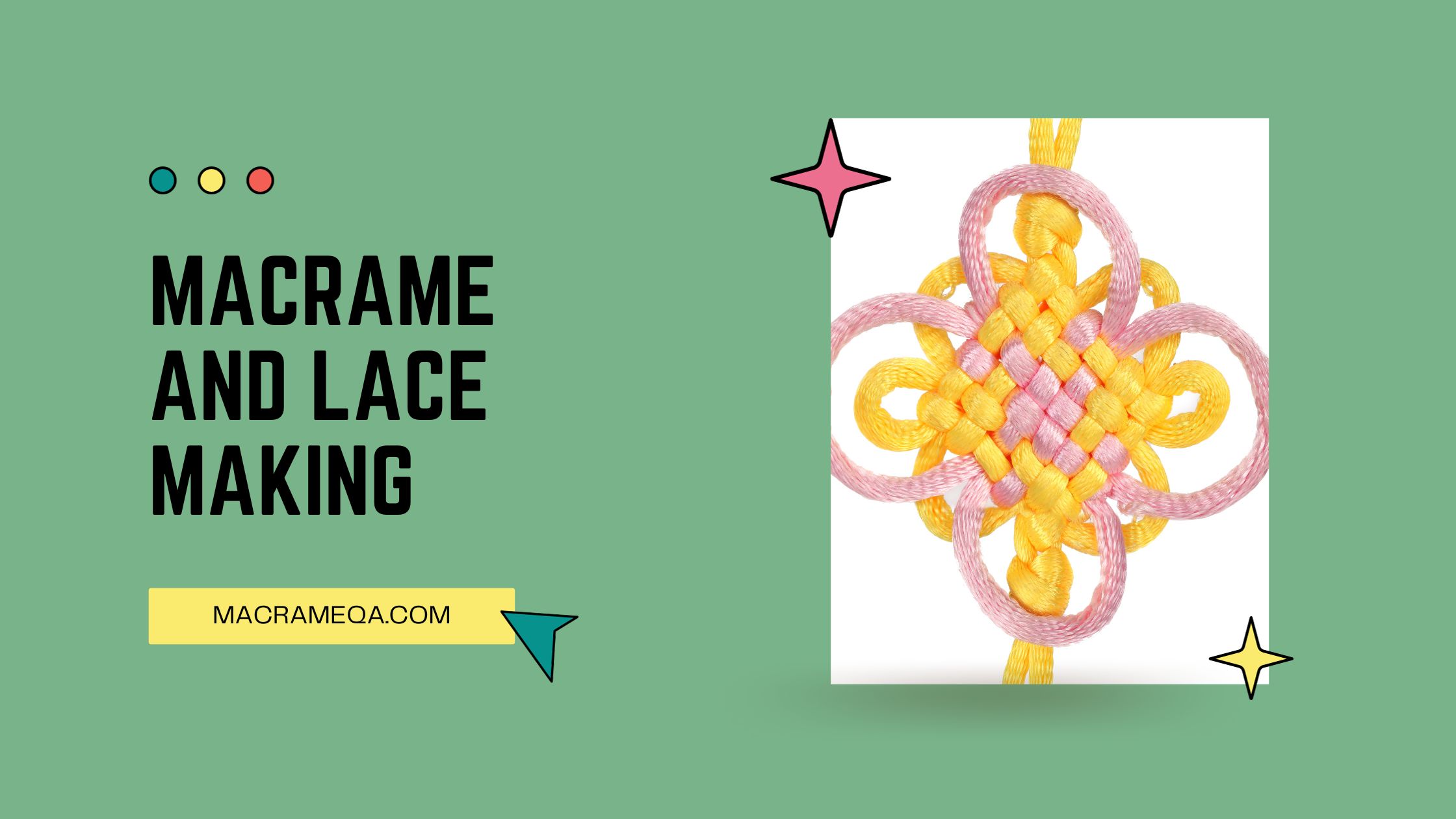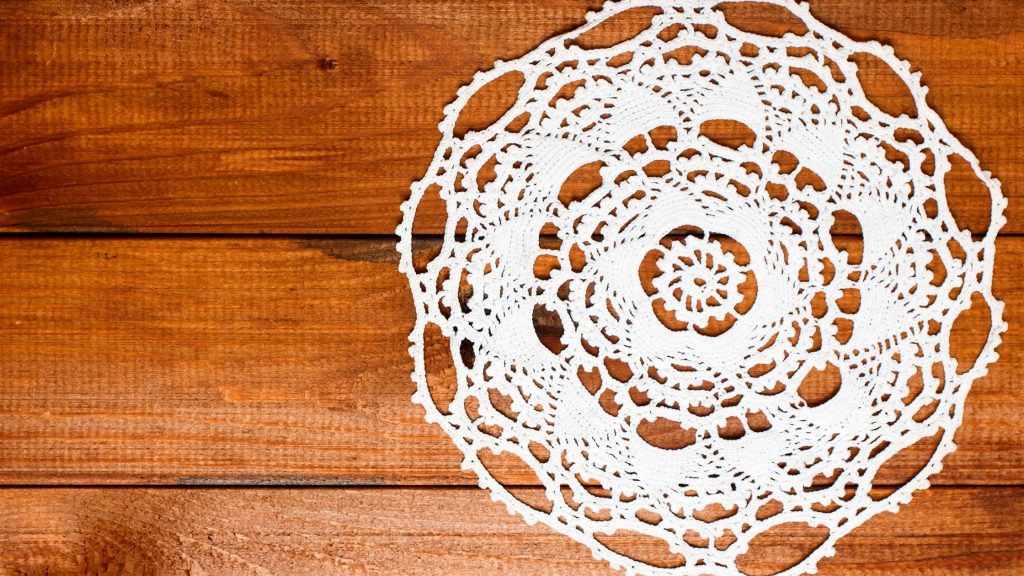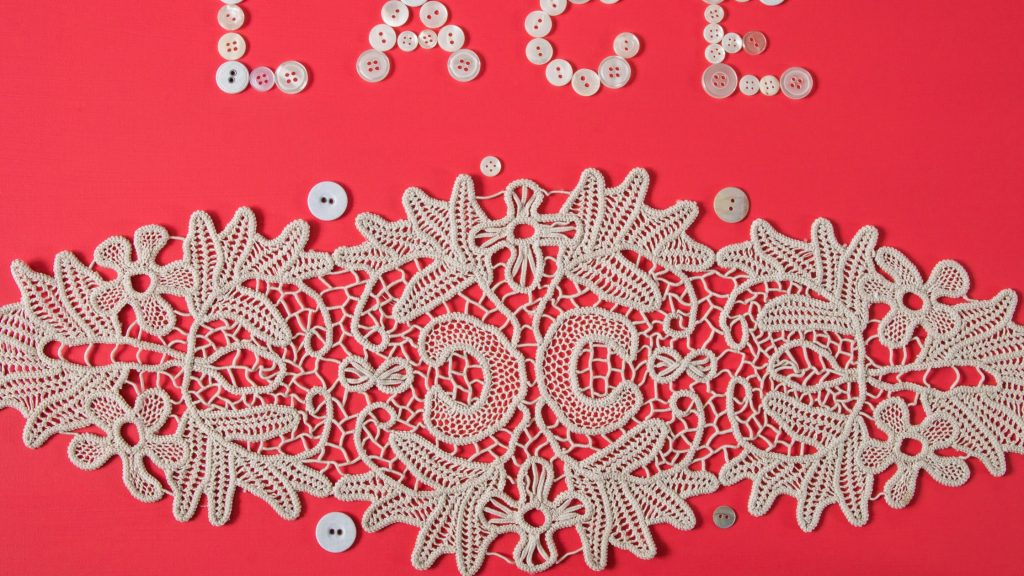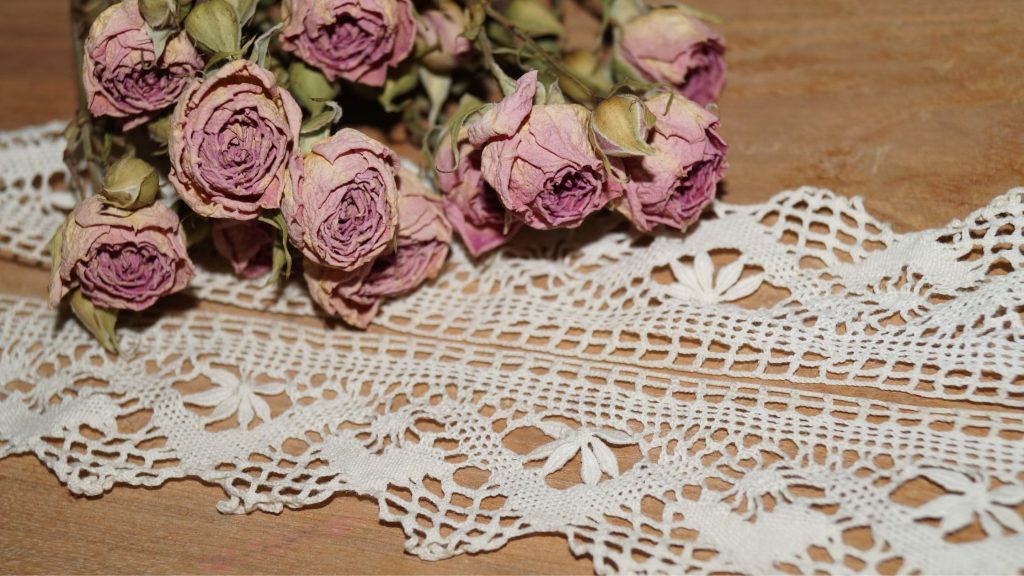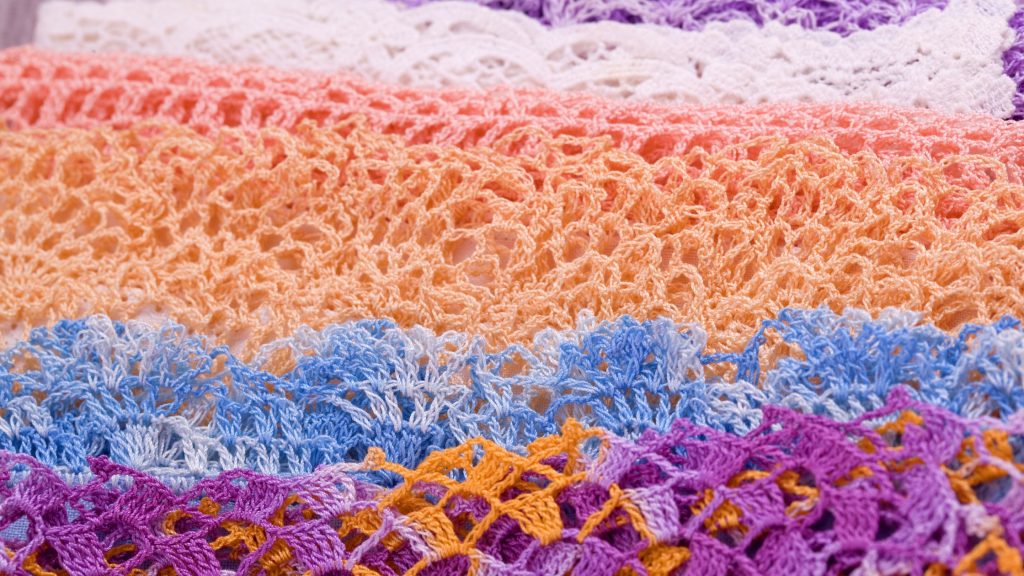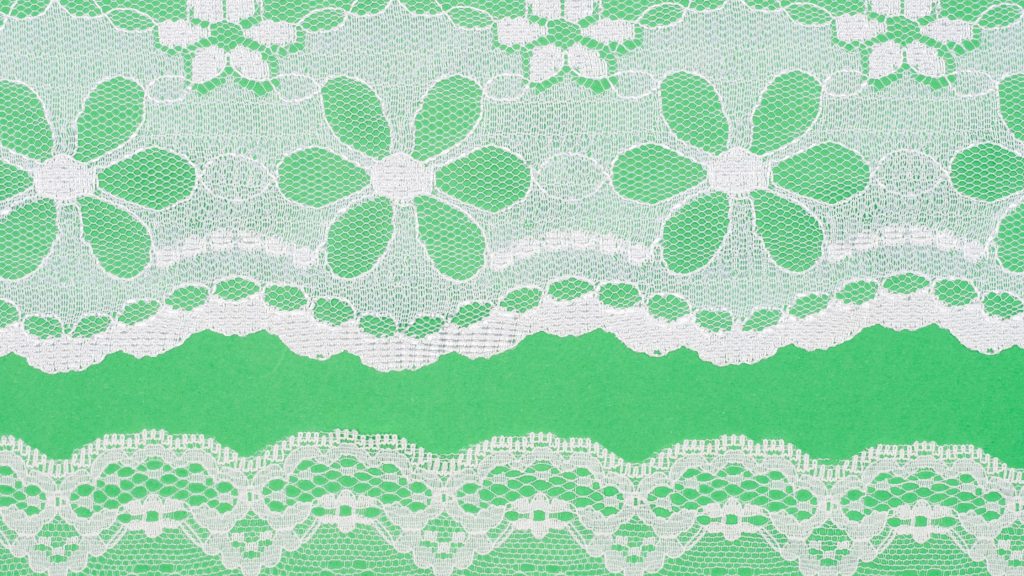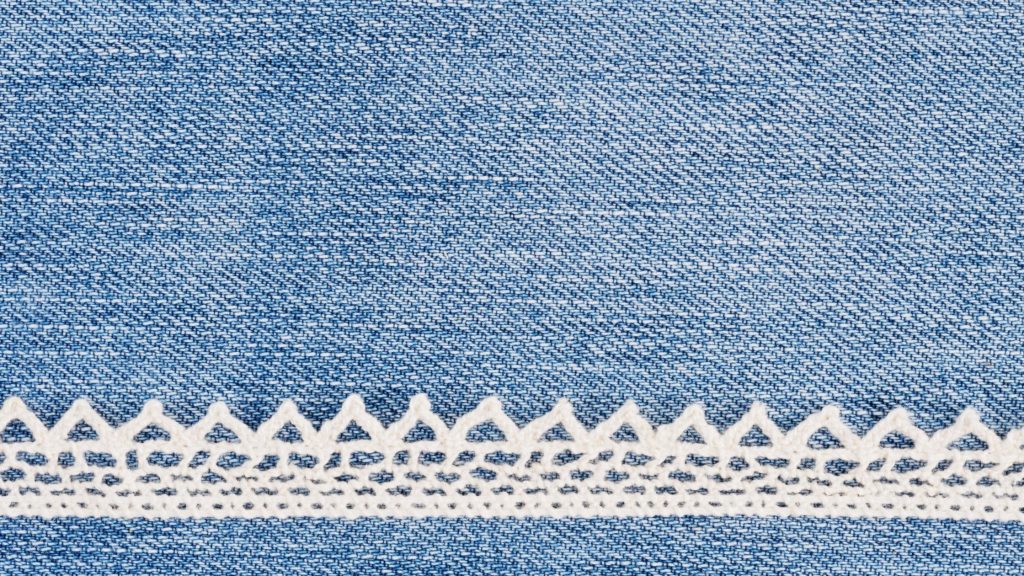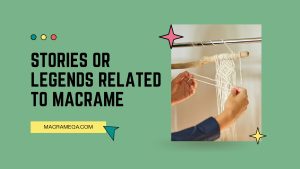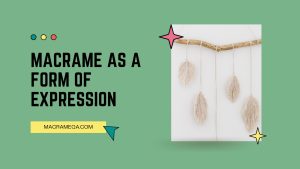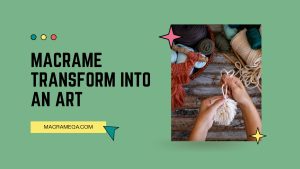Macrame and lace making, two breathtaking forms of craftsmanship, have long captured the imagination of artisans and admirers alike. Although distinct in their techniques and origins, these art forms share a deep-rooted relationship that intertwines their histories. Macrame, with its intricate knotting patterns, and lace making, renowned for its delicate and elaborate designs, both boast a common thread that weaves them together. In this article, we will explore the fascinating connection between macrame and lace making, tracing their intertwined evolution and discovering the beauty that arises when their paths converge. So, prepare to unravel the intricacies and uncover the harmony that exists within these captivating art forms.
Macrame and lace making are two distinct craft techniques that share similarities in their knotting techniques and working with threads or cords. While their origins and materials used may differ, both macrame and lace-making serve both decorative and functional purposes. Over the centuries, these crafts have evolved and been influenced by various cultures and industries, leading to their use in a wide range of applications. Today, macrame and lace-making continue to thrive in different regions, and their techniques and projects are accessible to beginners and advanced crafters alike. Learning these crafts can have numerous benefits, including enhancing creativity, developing fine motor skills, and providing therapeutic and mindfulness benefits. Macrame and lace-making communities and events, both online and offline, provide platforms for enthusiasts to connect, learn, and showcase their work. Efforts are also being made to preserve and revive ancient techniques, as well as adopt sustainable practices in these crafts.
History of Macrame and Lace Making
Origins of Macrame
Macrame is believed to have originated in the Middle East during the 13th century. It gained popularity during the Renaissance in Europe, where it was used for decorative purposes and as a means of making household items. The term “macrame” is derived from the Arabic word “miqramah,” which means “fringe.” Macrame became particularly popular during the Victorian era, with intricate designs adorning clothing, curtains, and other textiles.
Origins of Lace Making
Lace-making, on the other hand, has a long history that dates back to ancient civilizations such as Egypt, China, and India. However, it was in Europe during the 16th century that lace-making flourished. It was initially a luxury craft, practiced mainly by nuns and aristocratic women, but it eventually became more accessible to the general population. Lace-making centers emerged in different parts of Europe, including Flanders, Italy, and France, each with their distinct styles and techniques.
Early Differences in Techniques and Materials
While both macrame and lace making involve knotting, there are early differences in their techniques and materials used. Macrame primarily utilizes knotting techniques such as square knots, half-hitch knots, and lark head knots. These knots are usually created using thick cords or ropes made of materials like cotton, hemp, or synthetic fibers. Lace-making, on the other hand, involves intricate handwork and uses fine threads, typically made of linen, silk, or cotton. The techniques used in lace-making include twisting, looping, and braiding threads to create delicate and intricate patterns.
Similarities between Macrame and Lace Making
Both Use Knotting Techniques
One of the key similarities between macrame and lace making is their utilization of knotting techniques. In both crafts, knots are used to create patterns and structures. Macrame often features knots such as square knots, spiral knots, and double half-hitch knots, while lace making involves various knotting techniques like the reef knot, half stitch, and Ghiordes knot. The precise knotting techniques used in both crafts contribute to the intricacy and beauty of the final products.
Both Require Working with Threads or Cords
Another similarity between macrame and lace-making is the use of threads or cords. Whether it’s thick cords in macrame or fine threads in lace making, the choice of material plays a crucial role in the outcome of the project. The threads or cords can be manipulated, knotted, and woven to form the desired patterns and designs. The range of materials available allows for versatility in creating different textures and styles.
Both Have Decorative and Functional Purposes
Both macrame and lace-making serve both decorative and functional purposes. In macrame, intricate wall hangings, plant hangers, and curtains can be created to add visual interest to a space. Macrame items are often used as decorative elements in interior design, enhancing the aesthetic appeal of a room. Lace-making, on the other hand, has been traditionally used to adorn clothing, accessories, and home textiles. Lace trims, collars, and doilies are just a few examples of the functional and decorative applications of lace.
Differences between Macrame and lace-making
Materials Used
One of the significant differences between macrame and lace-making lies in the materials used. Macrame predominantly employs thick cords or ropes made of materials such as cotton, hemp, jute, or synthetic fibers. These materials give macrame its characteristic bohemian and rustic appeal. In contrast, lace-making relies on fine threads made of linen, silk, or cotton. The delicate nature of lace requires the use of lightweight and high-quality materials to achieve intricate details.
Techniques and Knots
While both macrame and lace-making involve knotting, the techniques and types of knots differ between the two crafts. Macrame commonly uses knots like square knots, half-hitch knots, and lark’s head knots, which create a variety of textured patterns. Lace making, on the other hand, involves knotting techniques such as the reef knot, half stitch, and Ghiordes knot, among many others. These intricate knots and techniques are specifically designed to create delicate and intricate lace patterns.
End Products
The final products of macrame and lace-making also vary in terms of their appearance and function. Macrame often results in larger, more substantial pieces such as wall hangings, plant hangers, and hammocks. These items are often designed to be visually striking and serve as focal points in a space. In contrast, lace-making generally produces smaller, intricate pieces such as doilies, collars, and lace trims. These delicate lace pieces add a touch of elegance and intricate detail to clothing, accessories, and home decor.
Evolution and Influences on Macrame and Lace Making
Cultural Influences
Throughout history, macrame and lace-making have been influenced by various cultures and regions. Macrame, for instance, saw a significant surge in popularity during the 1970s as part of the bohemian movement, influenced by the aesthetics of the Middle East and North Africa. In contrast, lace-making has been influenced by the cultural traditions of specific regions in Europe, such as the Venetian lace and the Irish crochet lace. These cultural influences have shaped the designs and techniques used in both crafts, adding diversity and unique elements to their respective traditions.
Fashion Industry Impact
The fashion industry has played a significant role in shaping the evolution of macrame and lace making. Both crafts have been utilized in various fashion trends and styles throughout the years. Macrame gained popularity in the 1960s and 1970s as a symbol of the bohemian lifestyle, with macrame garments and accessories being worn by fashion icons. Similarly, lace-making has been a staple in fashion, adorning wedding dresses, lingerie, and evening wear. The fashion industry’s embrace of macrame and lace making has not only kept these crafts relevant but has also inspired innovative techniques and designs.
Modern Applications
In addition to their historical significance, macrame and lace-making have found new applications in modern contexts. Macrame has experienced a resurgence in popularity in recent years, with contemporary artists and designers incorporating macrame techniques into various forms of art, interior design, and fashion. Likewise, lace-making has expanded beyond traditional applications, with lace-inspired patterns and textiles being used in contemporary fashion and interior design. The versatility of both crafts allows for continuous exploration and adaptation to new trends and aesthetics.
Macrame and Lace Making in Different Regions
European Lace-Making Tradition
Europe has a rich tradition of lace making, with distinctive styles originating from different regions. Some of the well-known types of lace include Belgian lace, French lace, and Venetian lace. Belgium is famous for its delicate needle lace, characterized by its intricate detailing and fine craftsmanship. French lace, particularly the renowned Alençon lace, is celebrated for its elegance and grace, often used in couture fashion. Venetian lace from Italy is recognized for its airy and delicate appearance, featuring intricate floral and geometric motifs.
Macrame in the Americas
Macrame has a strong presence in the Americas, particularly in Central and South America. The craft was introduced to these regions by Spanish colonizers and African slaves. In countries like Peru and Brazil, macrame techniques have been seamlessly integrated into the native textile traditions, resulting in vibrant and colorful macrame creations. Macrame is often seen in the form of textiles, accessories, and home decor products, showcasing the influence of indigenous cultures and local craftsmanship.
Asian and African Influences
Macrame and lace making have also found their way into Asian and African cultures, with unique influences on the crafts. In Asia, countries like India, China, and Japan have their own variations of lace making, incorporating traditional techniques and motifs. African cultures, such as those in Morocco and Egypt, have their own rich macrame traditions, with beautiful knotting patterns and designs. The infusion of cultural elements in macrame and lace-making adds a global perspective and diversity to these crafts.
Contemporary Uses of Macrame and Lace Making
Home Decor and Interior Design
Both macrame and lace-making have gained popularity in the realm of home decor and interior design. Macrame wall hangings, plant holders, and curtains are frequently used to add texture and visual interest to living spaces. The intricate patterns and delicate nature of lace also make it a sought-after material for home textiles, such as tablecloths, curtains, and bedding. Incorporating macrame and lace pieces into home decor allows for a unique and personalized touch that adds warmth and charm to any space.
Fashion and Accessories
Macrame and lace-making have a strong presence in the world of fashion and accessories. Macrame techniques are often used to create fashionable garments, swimsuits, and accessories like bags and jewelry. In the realm of lace, wedding dresses, lingerie, and evening gowns often feature lace embellishments or overlay, adding a touch of elegance and romance. Both macrame and lace pieces are valued for their intricate craftsmanship and ability to elevate any outfit or accessory.
Art and Crafts
Beyond their functional applications, macrame and lace-making have become forms of artistic expression. Contemporary artists and crafters experiment with these techniques to create unique works of art. Macrame sculptures, installations, and wall art showcase the versatility of the craft and its ability to transcend traditional boundaries. Similarly, lace-making has evolved into an art form, with artists pushing the boundaries of traditional techniques to create innovative and avant-garde lace pieces. The art and craft world provides a platform for macrame and lace enthusiasts to explore their creativity and showcase their skills.
Macrame and Lace Making Techniques and Projects
Basic Knots and Techniques for Beginners
For beginners, learning the basic knots and techniques is essential in both macrame and lace making. Macrame beginners can start by mastering knots such as the square knot, half-hitch knot, and lark’s head knot. These foundational knots are building blocks for creating various macrame designs. In lace making, beginners can start with simple techniques like the running stitch and the half stitch, gradually progressing to more complex techniques like bobbin lace or needle lace. Online resources and tutorials provide step-by-step guidance for beginners to learn these techniques and create their own projects.
Intermediate and Advanced Projects
Once the basic knots and techniques are mastered, crafters can progress to intermediate and advanced projects in macrame and lace making. In macrame, this can involve creating more intricate patterns, experimenting with different knot combinations, and incorporating more diverse materials. Advanced macrame projects could include large-scale wall hangings, macrame furniture, or even three-dimensional sculptures. In lace making, crafters can tackle more complex lace patterns, create lace garments, or explore innovative lace techniques. As crafters gain confidence and experience, the possibilities for creative and challenging projects expand.
Resources and Tutorials for Further Learning
There is a wealth of resources and tutorials available for individuals looking to further their knowledge and skills in macrame and lace making. Online platforms, such as blogs, websites, and video tutorials, offer comprehensive guides for beginners, as well as advanced techniques for experienced crafters. Books and specialized publications also provide in-depth information on specific macrame and lace-making techniques, as well as historical and cultural contexts. Additionally, workshops, classes, and online courses offer hands-on learning experiences and opportunities to connect with other enthusiasts.
Benefits of Learning Macrame and Lace Making
Enhancing Creativity and Relaxation
Learning macrame and lace-making can enhance creativity by providing an outlet for self-expression and experimentation. These crafts offer endless possibilities for design, color combinations, and materials, allowing crafters to create truly unique pieces. Engaging in macrame and lace-making can also be a source of relaxation and stress relief. The repetitive motions involved in knotting and working with threads can have a calming effect, promoting mindfulness and a sense of accomplishment.
Developing Fine Motor Skills
Both macrame and lace-making require precision and attention to detail, which can help develop fine motor skills. The delicate handling of threads or cords and the intricate knotting techniques help refine hand-eye coordination and dexterity. Practicing these crafts can improve manual skills, finger strength, and overall agility. As crafters progress to more complex projects, their fine motor skills are continually challenged and refined.
Therapeutic and Mindfulness Benefits
Engaging in macrame and lace-making can have therapeutic benefits for individuals. The process of creating and focusing on intricate patterns can act as a form of meditation, relieving stress and promoting mindfulness. The rhythmic movements of knotting and the tactile experience of working with threads can create a calming and centered state of mind. Engaging in these crafts can serve as a form of self-care, allowing individuals to take a break from daily stresses and immerse themselves in a creative and mindful activity.
Macrame and Lace Making Communities and Events
Online Communities and Forums
The internet has provided a platform for macrame and lace-making enthusiasts to connect, share ideas, and seek advice. Online communities and forums dedicated to these crafts allow individuals to interact with fellow crafters from around the world. Crafters can share their projects, ask for help or inspiration, and engage in discussions about techniques and materials. These online communities provide a supportive and inclusive environment for individuals at all skill levels and serve as a valuable resource for learning and networking.
Macrame and Lace Making Workshops and Retreats
Workshops and retreats offer opportunities for crafters to immerse themselves in hands-on learning experiences and connect with other enthusiasts. These events are often led by experienced crafters who share their knowledge and skills through demonstrations and guided projects. Workshops and retreats provide an environment for individuals to learn new techniques, receive personalized guidance, and foster a sense of community with fellow crafters. These events can be found both online and offline, catering to different schedules and locations.
Exhibitions and Trade Shows
Exhibitions and trade shows dedicated to macrame and lace making allow crafters to showcase their creations and connect with a broader audience. These events provide a platform for designers, artists, and crafters to display their work, gain recognition, and network within the industry. Exhibitions often feature a range of macrame and lace pieces, highlighting different techniques, styles, and applications. Trade shows, on the other hand, offer opportunities for individuals to explore and purchase materials, tools, and finished products related to macrame and lace making.
Preserving and Reviving Macrame and Lace Making
Craft Organizations and Preservation Efforts
Various craft organizations and preservation societies are dedicated to the preservation and promotion of macrame and lace making. These organizations ensure that traditional techniques and skills are passed down to future generations. They often offer classes, workshops, and resources for learning and preserving these crafts. Through research, documentation, and education initiatives, these organizations play a crucial role in preserving the historical significance and cultural heritage of macrame and lace-making.
Reviving Ancient Techniques
Alongside preservation efforts, there is a growing interest in reviving ancient techniques in macrame and lace making. Crafters and artists are exploring historical patterns, studying traditional methods, and adapting them to modern designs. By reviving these techniques, contemporary crafters pay homage to the craftsmanship of past generations while infusing their own creative twist. This revival serves as a bridge between the rich history of macrame and lace making and its relevance in the modern world.
Sustainable Practices in Macrame and Lace Making
As awareness of sustainability grows, crafters and designers adopt sustainable practices in macrame and lace making. This includes the use of natural and ethical materials, such as organic cotton, linen, and recycled fibers. Crafters are also exploring eco-friendly dyeing methods and reducing waste in their production processes. By incorporating sustainability into these crafts, macrame, and lace-making can remain environmentally responsible and contribute to a more conscious approach to crafting.
Conclusion
In conclusion, macrame and lace making are two crafts that have evolved over centuries and have been influenced by various cultures and industries. Despite their differences in materials, techniques, and end products, both crafts share a common foundation in knotting techniques and working with threads or cords. Macrame and lace-making serve both decorative and functional purposes, adding beauty, texture, and elegance to a wide range of applications.
With a rich history and a place in modern design and art, macrame and lace-making continue to thrive in different regions and inspire crafters around the world. Whether as a hobby or a profession, learning macrame and lace-making offers numerous benefits, from enhancing creativity and developing fine motor skills to providing therapeutic and mindfulness benefits. The presence of online communities, workshops, and exhibitions fosters a sense of community and opportunity for further growth and exploration. Through preservation efforts, revival of ancient techniques, and sustainable practices, macrame and lace-making can continue to flourish while honoring their historical roots.

